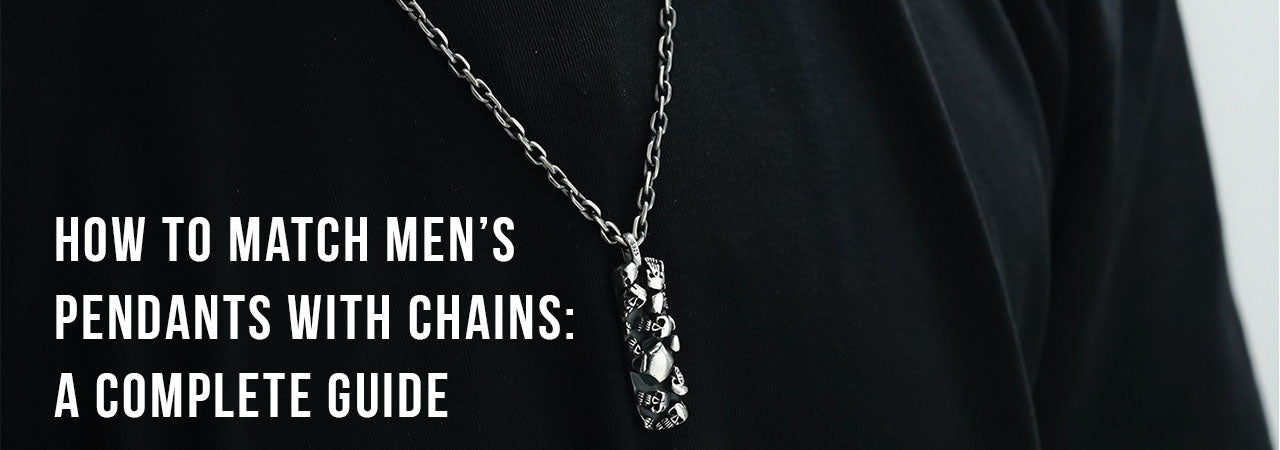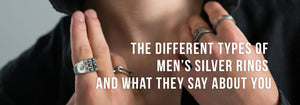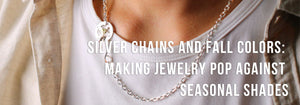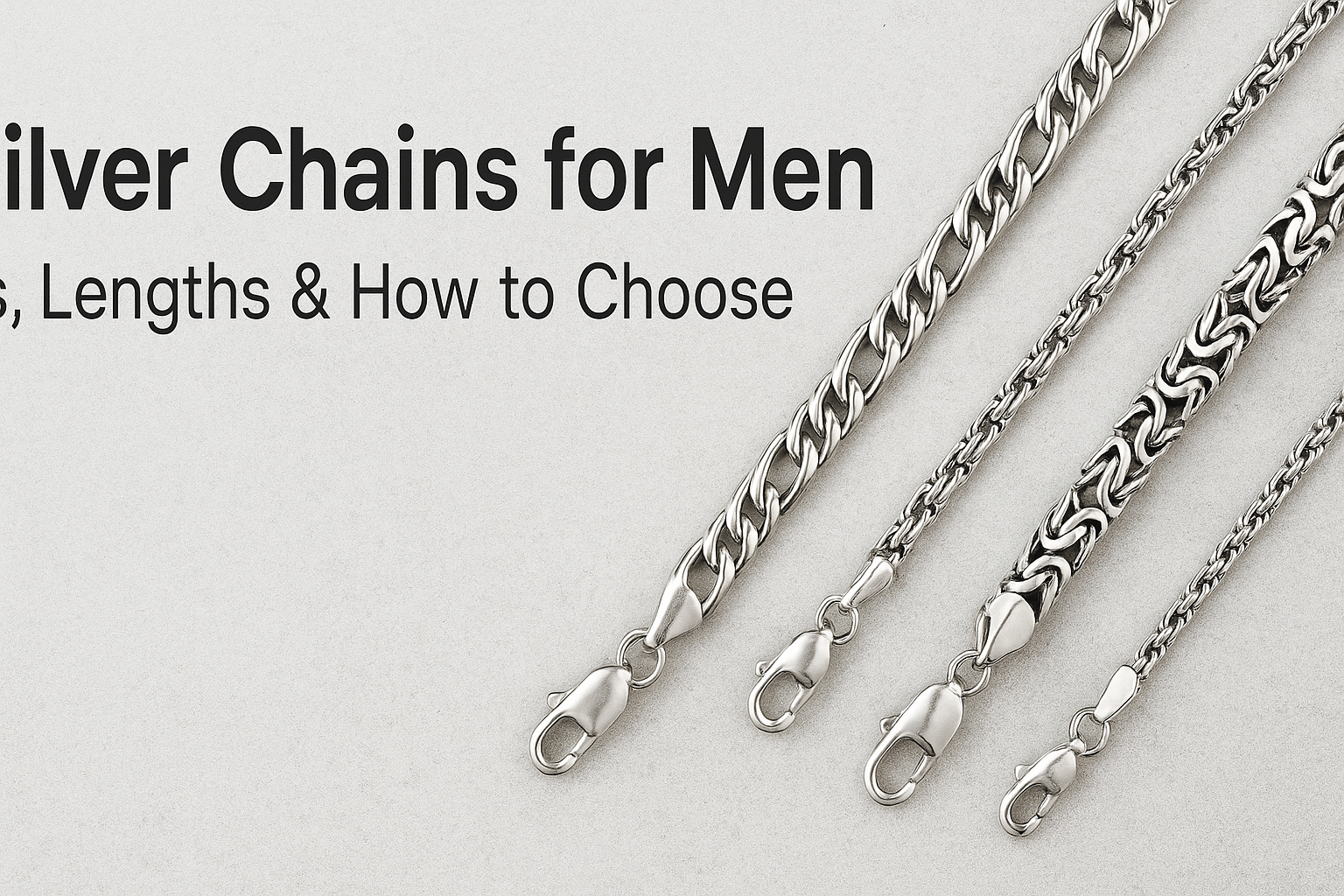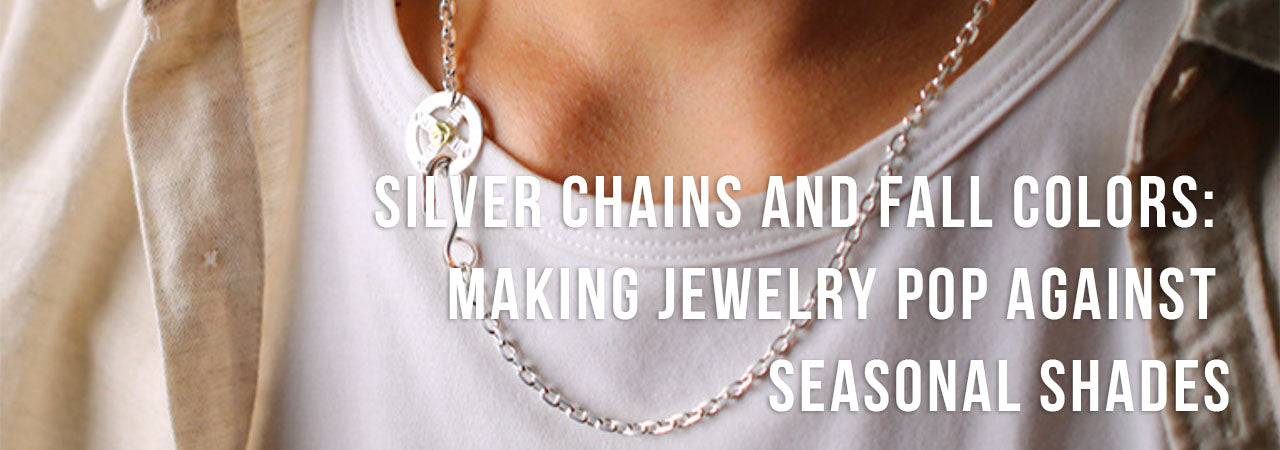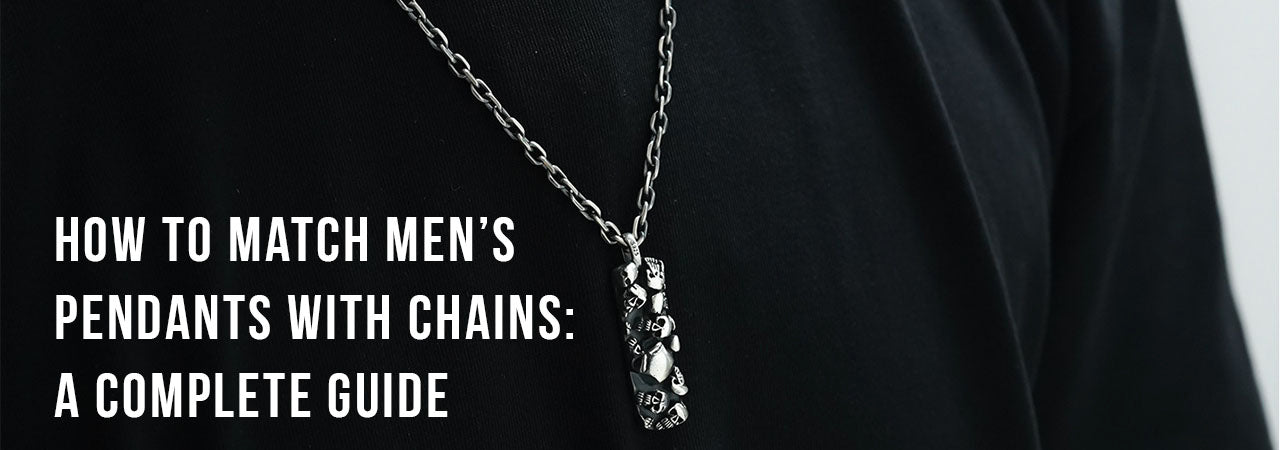En matière de bijoux pour hommes, la qualité d'un collier pendentif dépend de la chaîne qui l'accompagne. Le pendentif peut attirer l'attention, mais c'est la chaîne qui confère à l'ensemble un aspect équilibré, confortable et durable. Un mauvais accord peut faire paraître le plus beau pendentif déplacé. Un bon accord vous donnera un collier à la fois élégant et raffiné.
Ce guide explique comment associer différents types de pendentifs pour homme avec les chaînes adaptées. Nous expliquerons l'importance des proportions, les styles de chaînes qui s'accordent avec les pendentifs populaires comme les croix, les plumes, les symboles bouddhistes, les têtes de mort et les modèles minimalistes, ainsi que des conseils pratiques pour vous aider à choisir la longueur, l'épaisseur et la finition. Que vous achetiez votre premier collier avec pendentif ou que vous renouveliez votre collection, ces conseils vous permettront de toujours associer parfaitement votre chaîne et votre pendentif.
Partie 1 : Pourquoi la correspondance est importante
La chaîne et le pendentif ne sont pas des pièces séparées : ils forment un tout. S'ils sont dépareillés, cela se voit immédiatement.
- La proportion est primordiale. Un pendentif lourd sur une chaîne fine paraît fragile et risque de se casser. Un petit pendentif discret sur une chaîne épaisse se perd dans le poids des maillons. Un juste équilibre confère au collier un aspect intentionnel.
- La durabilité dépend de l'association. Les pendentifs sont lourds, et la chaîne doit le supporter. Les pendentifs plus épais nécessitent des chaînes solides comme des mailles d'ancre ou des chaînes à épis, tandis que les pendentifs plus légers peuvent être portés confortablement sur des chaînes à mailles fines ou à mailles carrées.
- Le style doit être fluide. Un pendentif a sa propre personnalité : audacieux, minimaliste, spirituel ou raffiné. La chaîne doit refléter ce style, et non le contredire. Lorsqu'ils sont en harmonie, le collier est complet.
En bref : la solidité et l'élégance d'un collier pendentif dépendent de son maillon le plus faible. Assortissez-les bien pour une pièce plus durable et plus élégante.
Partie 2 : Styles de pendentifs courants et leurs meilleures correspondances de chaîne
Toutes les chaînes ne conviennent pas à tous les pendentifs. Le design, le poids et la signification du pendentif doivent guider le choix de la chaîne. Voici quelques-uns des modèles de pendentifs pour hommes les plus populaires et les chaînes qui les complètent le mieux :
- Idéal avec : chaînes à maillons d'ancrage, chaînes à blé
- Pourquoi ils fonctionnent : Ces chaînes équilibrent force et tradition, faisant écho au poids symbolique d'une croix tout en gardant un look classique et durable.
- Idéal avec : chaînes à billes, chaînes rolo
- Pourquoi ils fonctionnent : Leurs maillons simples et arrondis créent un look épuré et minimaliste qui correspond à l'esthétique calme et zen des symboles bouddhistes.
- Idéal avec : chaînes à maillons d'ancre, chaînes à corde fine
- Pourquoi ils fonctionnent : Les conceptions de chaîne élégantes permettent aux détails fins de la plume de se démarquer sans la dominer.
- Idéal avec : chaînes à maillons d'ancrage épaisses, chaînes à billes
- Pourquoi ils fonctionnent : Des chaînes solides et robustes mettent en valeur le style audacieux et rustique des pendentifs en forme de crâne, gardant la pièce ancrée.
Pendentifs minimalistes / géométriques
- Idéal avec : chaînes à blé, chaînes à boîte
- Pourquoi ils fonctionnent : Les motifs de chaîne épurés et structurés font écho à l'esthétique moderne et simple des pendentifs minimalistes ou géométriques.
Partie 3 : Choisir la bonne longueur de chaîne
La longueur de la chaîne modifie la position du pendentif et son attrait. Choisir une mauvaise longueur peut rendre une combinaison chaîne-pendentif aussi harmonieuse qu'elle puisse paraître étrange.
- Chaînes courtes (18–20 pouces)
- Asseyez-vous haut sur la poitrine, généralement juste en dessous de la clavicule.
- Idéal pour les petits pendentifs légers comme les designs minimalistes ou géométriques.
- Fonctionne bien sous les chemises ou pour un look quotidien subtil.
- Chaînes mi-longues (22–24 pouces)
- L'option la plus polyvalente.
- Les pendentifs reposent au milieu du coffre, où ils sont visibles sans être trop visibles.
- Idéal pour les pendentifs en croix, les plumes ou les pendentifs bouddhistes de taille moyenne.
- Longues chaînes (26–30 pouces)
- Les pendentifs sont placés plus bas, plus près du sternum ou même de la partie supérieure de l'estomac.
- Idéal pour les pendentifs audacieux comme les crânes ou les plaques d'identité surdimensionnées.
- Habituellement porté à l'extérieur de la chemise pour un look fort et accrocheur.
Conseil : Pensez à votre silhouette et à votre style. Un torse long aura peut-être besoin d'une chaîne légèrement plus longue pour que le pendentif soit bien en place, tandis qu'une personne plus petite préférera des chaînes mi-longues pour plus d'équilibre.
Partie 4 : Les finitions et les métaux sont importants
Il ne s’agit pas seulement du style ou de la longueur de la chaîne : la finition et le métal font une grande différence dans l’aspect poli du collier.
-
Associez les métaux autant que possible.
Un pendentif en argent sterling est particulièrement beau avec une chaîne en argent sterling. Mélanger des métaux (comme l'or et l'argent) peut fonctionner, mais cela donne souvent un effet déséquilibré, sauf intentionnel. - Faites attention aux finitions.
- Poli : les chaînes brillantes ajoutent de la luminosité et font ressortir les pendentifs détaillés.
- Mat ou brossé : un look plus subtil qui s'accorde bien avec des suspensions minimalistes.
- Oxydé ou antique : ajoute de la profondeur et se marie bien avec des pendentifs rustiques comme des crânes ou des motifs d'inspiration tribale.
-
La cohérence est importante.
Si le pendentif présente une finition plus foncée ou oxydée, une chaîne très polie pourrait paraître déplacée. L'harmonie des tons confère à la pièce une certaine cohérence. -
La durabilité compte.
Les chaînes en argent sterling de haute qualité résistent mieux au ternissement et peuvent supporter des pendentifs plus lourds sans s'étirer ni se casser.
En cas de doute, tenez-vous-en au même métal et à une finition similaire : c'est le moyen le plus simple de vous assurer que votre pendentif et votre chaîne semblent aller ensemble.
Partie 5 : Conseils pratiques avant d'acheter
Avant de vous engager dans une chaîne pour votre pendentif, gardez ces points à l’esprit :
-
Vérifiez la taille de la caution.
L'anse (la boucle par laquelle passe la chaîne) doit être adaptée à la chaîne. Une chaîne à maillons épais ne glissera pas dans une anse plus petite. -
Associez le poids à la durabilité.
Les pendentifs lourds nécessitent des chaînes plus solides, comme des mailles d'ancre ou des chaînes à épis. Les pendentifs légers peuvent être utilisés avec des chaînes à mailles fines ou des chaînes à mailles carrées. -
Pensez au confort.
Les chaînes larges ou épaisses peuvent être lourdes autour du cou si elles sont portées toute la journée. Si vous prévoyez de porter votre collier souvent, testez-le avant de vous engager. -
Avoir plus d'une chaîne.
Un pendentif polyvalent peut avoir un rendu radicalement différent sur une fine chaîne torsadée ou sur un maillon d'ancre audacieux. Posséder au moins deux options de chaîne vous permet de changer de look sans acheter de nouveaux pendentifs. -
Achetez de la qualité.
Les chaînes en argent sterling massif valent l'investissement. Elles résistent mieux que les chaînes plaquées et maintiennent le pendentif en place.
Un peu de planification peut faire toute la différence. Choisir la bonne chaîne garantit un pendentif élégant, confortable et durable.
Conclusion
Un collier pendentif est bien plus qu'un simple pendentif sur une chaîne : les deux s'associent pour créer équilibre, confort et style. Une chaîne bien choisie met en valeur le pendentif sans l'occulter, tandis que la longueur et la finition idéales garantissent qu'il s'adapte à votre look et à votre style de vie.
Si vous associez un pendentif en forme de croix, de plume, de tête de mort, bouddhiste ou minimaliste, n'oubliez pas les règles de proportion, de durabilité et de fluidité. Associez les métaux et les finitions pour un look harmonieux, et n'hésitez pas à posséder plusieurs chaînes pour optimiser vos pendentifs.
En résumé : une chaîne bien assortie ne se contente pas de soutenir un pendentif, elle le complète. Explorez notre collection de chaînes et de colliers pendentifs en argent pour homme et trouvez des associations harmonieuses.

